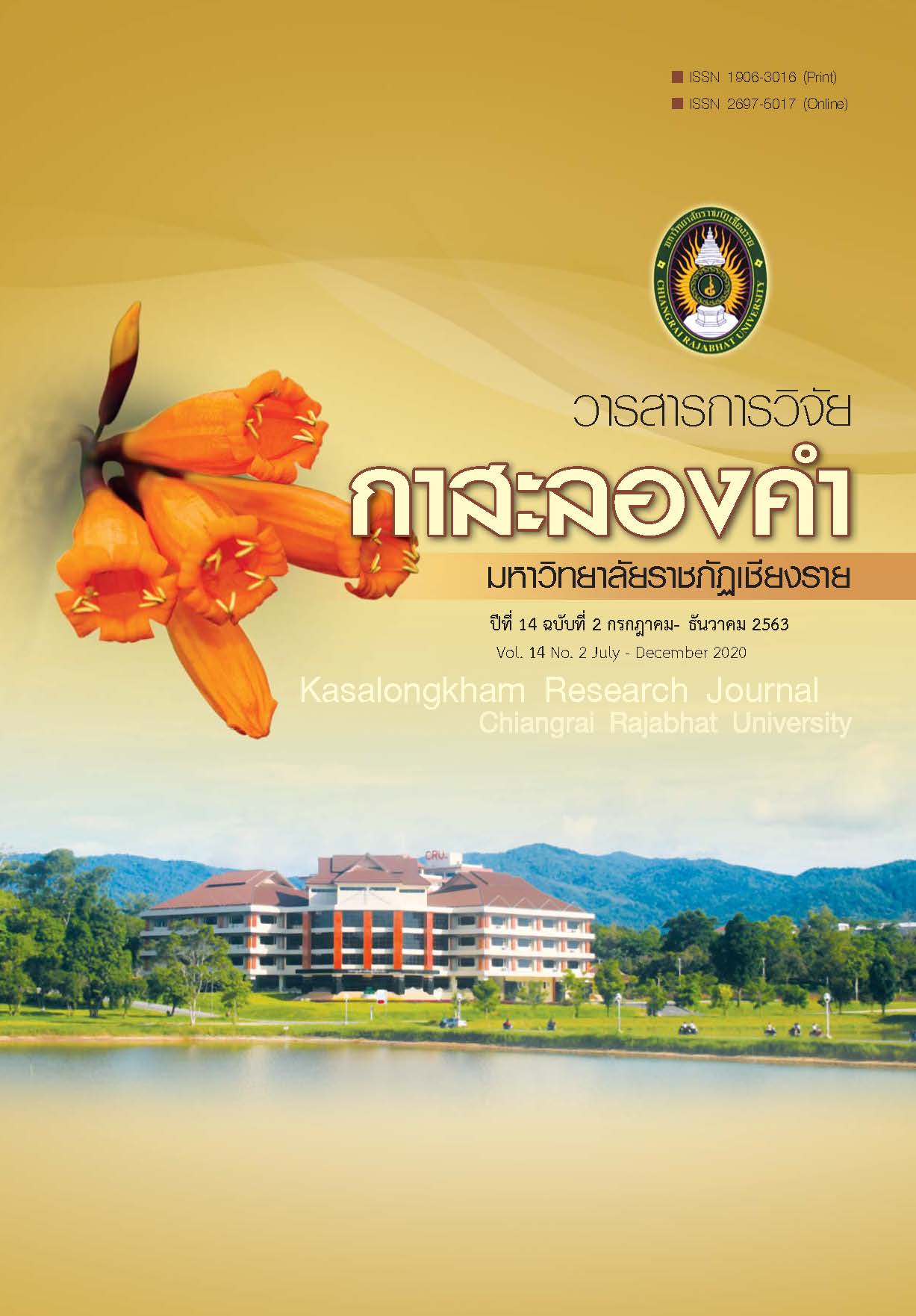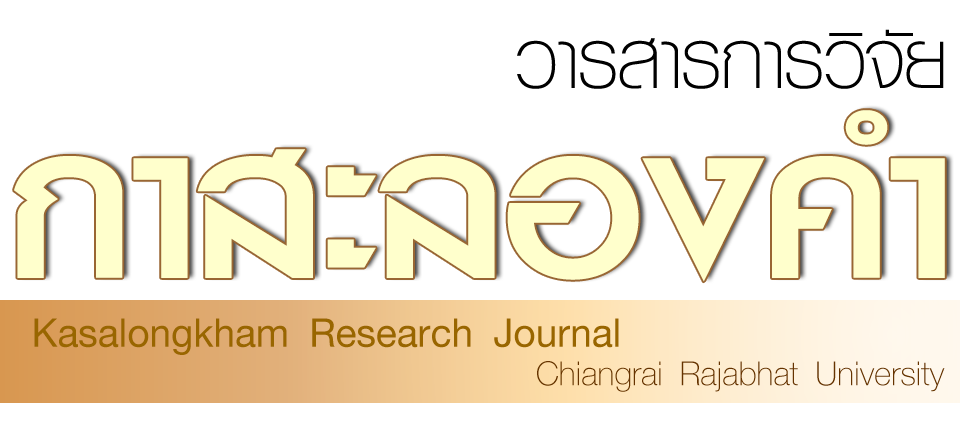THE DEVELOPMENT OF ENGLISH HANDOUT ON CAUSATIVE FORM BY USING AUGMENTED REALITY TECHNOLOGY FOR STUDENTS ON MATTHAYOMSUKSA 5
คำสำคัญ:
Handout, English Subject, Augmented Reality Technologyบทคัดย่อ
The purposes of this research were to 1) develop English handout on causative form by using augmented reality technology for Students on Matthayomsuksa 5 at good quality and the efficiency 80/80 of criteria, 2) compare the pre - test score with the study’s learning achievement score on causative form handout by using augmented reality technology, 3) study effectiveness index from using augmented reality technology handout, 4) study student’s satisfactions toward augmented reality technology handout and 5) study the benefit and difficulty of augmented reality technology handout. The sample group were 10 Matthayomsuka 5 students at Santiratwittayalai school that selected from purposive sampling by choosing the students who had English grade point average below 3.00
The research results were as follows: 1) the English handout with augmented reality technology showed quality at very good level and showed efficiency at 81.00/83.33, 2) the student’s learning achievement score were higher than the pre-test score at .05 levels of significant, 3) the effectiveness index is 0.4789, 4) the student’s satisfactions on English handout were at the highest level ( = 4.78, S.D. = 0.39) and 5) the benefits of English handout with augmented reality technology were to stimulate for studying and can review the contents that not understanding with handout, and the difficulty was the English language in application couldn’t be changed so the teacher have to instruct the students how to use the application.
เอกสารอ้างอิง
กระทรวงศึกษาธิการ. (2557). แนวปฏิบัติตามประกาศกระทรวง เรื่องนโยบายการปฏิรูปการเรียนการสอน ภาษาอังกฤษ. กรุงเทพมหานคร : โรงพิมพ์คุรุสภา ลาดพร้าว.
ชุติมา สัจจานนท์. (2541). การเข้าสู่ตำแหน่งทางวิชาการของอาจารย์และเทคนิคการเขียนผลงานทาง วิชาการ. นนทบุรี : มหาวิทยาลัยสุโขทัยธรรมาธิราช.
ณัฐกร สงคราม. (2553). การออกแบบและพัฒนามัลติมีเดียเพื่อการเรียนรู้. (พิมพ์ครั้งที่ 1). กรุงเทพมหานคร : จุฬาลงกรณ์มหาวิทยาลัย.
บุญธรรม กิจปรีดาบริสุทธิ์. (2535). การวัดผลและประเมินผลการเรียนการสอน. (พิมพ์ครั้งที่ 2). กรุงเทพมหานคร : B&B.
ปภาณิน สินโน. (2558). ชุดการสอนความเป็นจริงเสริม เรื่อง ชนิดพรรณไม้ สำหรับ นักเรียนชั้น ประถมศึกษาปีที่ 5. (ศึกษาศาตรมหาบัณฑิต). มหาวิทยาลัยเทคโนโลยีราชมงคลธัญบุรี. ปทุมธานี.
เปรื่อง กุมุท. (2519). เทคนิคการเขียนบทเรียนโปรแกรม. กรุงเทพมหานคร : คณะศึกษาศาสตร์ มหาวิทยาลัยศรีนครินทรวิโรฒ.
พนิดา ตันศิริ. (2553). โลกเสมือนผสานโลกจริง (Augmented Reality). วารสารนักบริหารมหาวิทยาลัย กรุงเทพ. 30(2), 169–175.
ราตรีนันทสุคนธ์. (2553). หลักการวัดและประเมินผลการศึกษา. กรุงเทพมหานคร : จุดทอง.
สมนึก ภัททิยธนี. (2553). การวัดผลการศึกษา. มหาสารคาม : ภาควิชาวิจัยและพัฒนาการศึกษา คณะศึกษาศาสตร์มหาวิทยาลัยมหาสารคาม.
อารีวรรณ เอี่ยมสะอาด. (2561). การจัดการเรียนการสอนภาษาอังกฤษในระดับประถมศึกษา. วารสารวิชาการมหาวิทยาลัยราชภัฏบุรีรัมย์. 10 (1), 31-45.
อุไรวรรณ ศรีไชยเลิศ. (2560). การพัฒนาสื่อการสอนด้วยเทคโนโลยีโลกเสมือนจริง 2 มิติ แบบมีปฏิสัมพันธ์ เรื่อง ปรากฏการณ์ของโลกและเทคโนโลยีอวกาศ สำหรับนักเรียนชั้น ประถมศึกษาปีที่ 6. การประชุมสวนสุนันทาวิชาการด้านวิทยาศาสตร์และเทคโนโลยีระดับชาติครั้งที่ 1 การสร้างสรรค์และนวัตกรรมก้าวสู่ประเทศ ไทย 4.0. กรุงเทพมหานคร: มหาวิทยาลัยราชภัฏ สวนสุนันทา.
Hopkins, Charles D. and Antes, Richard L. (1985). Classroom Management and Evaluation. (2nd ed) U.S.A. : F.E. Pencock Publishing, Inc.






